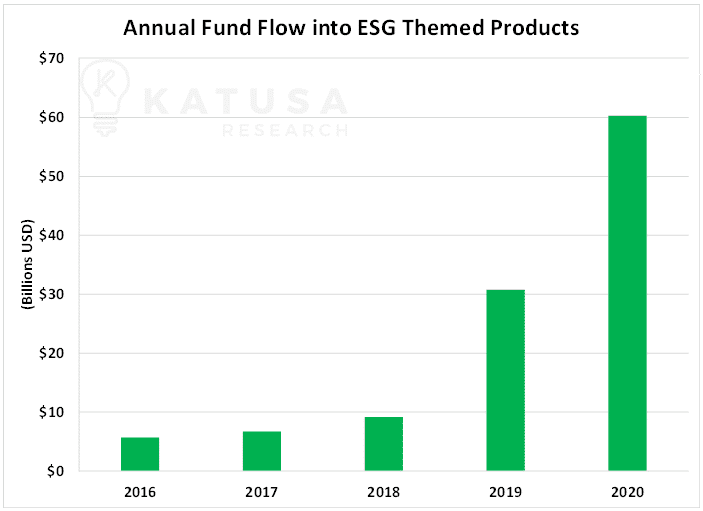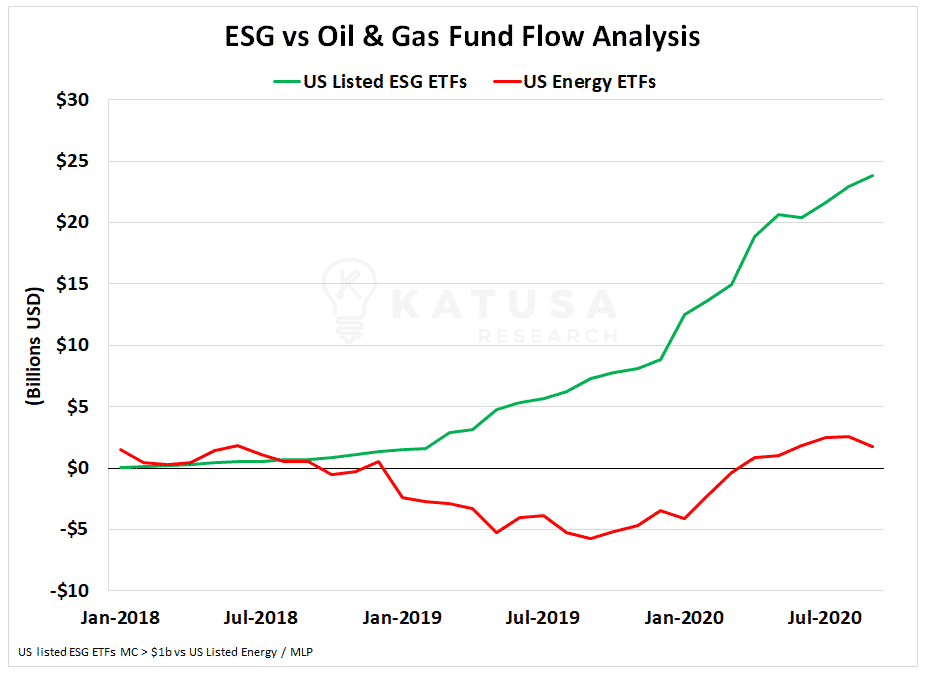ESG Investing Makes You “Feel Good”.
As Forbes correctly pointed out, there is another motive at play than just chasing big profits…
Investing in ESG companies and funds makes you look good.
- A recent poll found that nearly three-quarters (73%) of people think more positively of billionaires that stop investing in controversial industries.
Let’s face it, Cancel Culture is having a major impact on how things “look”.
And high net worth investors and fund managers can’t afford to have a bad social reputation.
Contrary to the old Wall Street movie from the 1980’s, greed is no longer good.
You have to do good to get greedy in the 2020’s.
Or your headquarters or projects will be met with protesters, resistance, media, and social attacks. Worst of all to the money managers, investors will pull their capital from you.
This is another risk factor that never existed before. Whether you are a mega-corp (like a Facebook or an oil company like Exxon), if you don’t have a directive on ESG – you’re going to fall behind, FAST.
This will be mission critical to attract and retain the next generation of employees and capital. Think Millennials and Gen Z as the wealth from Baby Boomers transfer to their kids.
These generations are rapidly increasing in the workforce right now in huge numbers and will be over the coming decades.
If you’re company isn’t socially responsible, or at least is making it look like they’re doing good. You will be left behind, no question.
What is ESG?
ESG stands for Environment, Social & Governance.
They’re a modern set of operating guidelines for companies that were established in the wake of the global shift towards the 2 biggest buzzwords today: sustainability and social responsibility.
The crux of ESG investing and ESG scoring is to align companies and investors, with these brand-new corporate values.
Let’s start by breaking down each of the components of ESG:
- Environmental
Measures the environmental friendliness of a company and its operations. If you’ve heard the terms “eco-friendly” or “carbon neutral” from a company before, that’s a prime example of the environment part of ESG.
- Social
Gauges a company’s attitude towards social concerns such as human rights, labor practices and diversity. Unsafe working conditions, glass ceilings and product safety would all fall under this umbrella.
- Governance
Or Corporate Governance. This comes down corporate structure and transparency, as well as business ethics. Executive compensation is the issue that most often comes to mind when corporate governance is brought up, as it’s a simple, if limited, metric of a company’s fairness and accountability.
When put together, each part of ESG comes together to form a comprehensive set of standards. It checks how well a company handles these prevailing issues and concerns.
Now, many financial firms now provide “ESG Ratings” on corporations for investors and regulators.
They do this to sort them by how well they perform based on the above mentioned ESG criteria.
In the past, the most important metrics for any company were the financial ones. A company that was growing quickly, or making a lot of money, was a good company.
What we’re seeing now, is that a company’s ESG metrics are also increasingly being taken into account.
This has led to the advent of “ESG investing”, which is also known as sustainable investing. Companies are weighed by their ESG metrics just as much as they are by their financial ones.
Follow the Money into ESG: An Avalanche of Capital Inflow
You can choose to get on board and be ahead of the green money in this corner of the market…
Or sit out the greatest coordinated capital infusion the world has ever seen.
Let me explain…
- Today, there are more than 597 ESG-focused ETFs (exchange-traded funds) with over $165 billion in Assets Under Management.
The flow of money into the ESG sector is approaching tidal wave standards.
Below is a chart which shows the annual flow of funds into ESG themed products.

How is ESG Impacting Companies?
On the surface, you might consider the rise of ESG and ESG investing to be a negative value proposition for companies.
After all, don’t things like environmental friendliness or competitive employee salaries cost the company more – which leads to weaker financial performance in the long run?
Not necessarily.
You start by considering a company’s environmental footprint, like its energy consumption and waste generation.
If a company can lower its energy costs and bills, that might lead to more savings, and hence better profits, over the long term.
Even if it costs more capital up front to, say, build a more energy-efficient office building or production facility.
And if they can produce less waste, that means less money spent on waste treatment and disposal too.
Whether the money saved fully offsets the extra costs involved will vary depending on the company and project in question.
But it’s certainly not as simple as “eco-friendly = more expensive”.
- Amazon, for instance, just recently placed a massive order for 100,000 custom electric delivery vehicles, as part of their plan to hit zero net carbon by 2040.
Not only will these vehicles be more environmentally friendly…
They’ll also feature a plethora of automatic electronic safety features and direct integration with Amazon’s logistics management and routing systems.
This will streamline their delivery operations – meaning both better performance and lower costs, down the road. And most likely be equipped with self-driving and robotic delivery abilities.
What about the costs of social concerns?
Like…
- Providing better salary and work environments for employees, or
- Taking more accountability when it comes to their products and services?
It’s no secret that treating your employees well leads to boosts in morale and productivity. And makes attracting talent much easier.
On the other hand, doing the opposite leads to decreased productivity and more employee turnover. That can be costly.
And when a company takes consumer protection more seriously, that leads a lower chance of adverse government regulation or expensive litigation.
The benefits of reducing corruption in any company should be plainly obvious…
Without enough transparency and accountability from a company’s leaders and operations, you end up with cases like WeWork.
WeWork’s failed IPO in 2019 was tainted by serious failures in proper corporate governance. It was all in connection with its now ousted founder and CEO, Adam Neumann.
Finally, one of the last factors that can cause ESG to seriously impact companies is simply consumer and investor appeal.
The younger generations of today have shown an increased willingness to “vote with their wallets”.
And many make the conscious decision to avoid products or brands associated with companies with histories of poor ESG performance.
Adapt or Die: The Knockout Combination
To show this shift in consumer and investment sentiment, we can look at something called Fund Flow. It is the net creation of shares for ETFs.
To make it easy for you – the greater the fund flow, the greater demand there is for the product.
Let’s take the Top 10 ESG ETFs and compare them to the Top 10 Oil & Gas ETFs.

This is a major shift in sentiment.
What’s the Outlook for ESG?
Make no mistake, ESG is here to stay and will only become a more dominant theme.
Though, how companies are measured against one another and scored based on their ESG practice will likely change.
For example…
One major problem with ESG is that there’s no set standard or clear methodology for evaluating a company’s ESG profile.
Different analysis firms can give different ESG ratings for the same company.
You can see how that could be confusing for consumers and investors alike.
Another big problem with ESG investing is that criteria are often applied incorrectly in the due diligence process. That’s where analyst take a much deeper dive into the data and company.
Sometimes, investors place too much importance on ESG criteria and not enough on fundamental financial analysis. And that leads to wrong valuations.
At other times, investors only take a cursory look at a company’s ESG rating without looking closer to check the exact breakdown. This causes them to miss any significant underlying issues at play.
- A study conducted by Nielsen in 2015 found that 66% of consumers around the world are willing to pay extra for sustainable products – but for millennials, that proportion goes up to 73%.
And it’s not just empty talk…
Last year, NYU concluded from extensive research that products marketed as sustainable accounted for 50% of the growth in consumer packaged goods from 2013 to 2018.
In fact, sales for products marked as sustainable grew 5.6 times faster than those that didn’t.
This impact from ESG on customer and revenue growth simply can’t be ignored.
This is, in part, due to the massive $30 trillion generational wealth transfer that we’re just starting to see take place. The aging baby boomer population is passing on their assets on to their millennial children.
A survey conducted by Morgan Stanley in 2019 found that 95% of millennials are interested in sustainable investing.
And 88% of all surveyed believe that it’s possible to balance financial gains with ESG considerations.
What this all means is that ESG isn’t just a passing fad…
It’s already a major business and investing trend, and one that will only continue to grow in size and importance.
Whether you truly believe that ESG investing can beat the market… Wish only to invest in socially responsible companies…Or even think it’s a load of bull…
ESG is around to stay.
That’s why it’s important to understand both the benefits and the pitfalls of ESG investing.
Regards,
Marin



